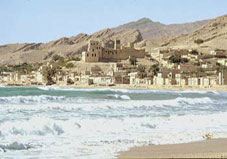
To next page
Ibn al-Balhi : Fars-namah (1117)
(history and geography of Fars) Persia
-----------------------------------------------
Taken from : Ibn al Balhi ; the Book of Fars.
Siraf and its Neighborhood. Siraf in old times was a great city, very populous and full of merchandise, being the port of call for caravans and ships. Thus in the days of the [Abbasid] Caliphs it was a great emporium, for here might be found stores of attar [of roses] and aromatics such as camphor, aloes, sandal-wood, and the like. [For its merchants] immense sums of money were to be gained here, and so matters continued till the last days of the Buyid supremacy. Then, however, the ancestors of the present Amir Kaysh attained to power, and they got into their possession the Island of Qays and the other neighboring islands, whereby the revenue that had formerly been taken by Siraf was cut.
(this is the story of the end of Siraf as a trading city, being replaced by Qays)
SEAS AND LAKES
In regard to the seas and lakes of Fars, the Persian Gulf [Bahr Fars, otherwise called] the Sea of Fars, is an arm of the Great Sea, which best is known as the Green Sea, being also called the Circumambient Ocean. On the shores of the Green Sea lie the lands of China, Sind and India, Oman, Aden, Zanzibar, and Basrah with diverse other districts; and each particular arm of the Green Sea bears the special name of the province whose lands lie on its shores. Thus we have [one arm called] the Sea of Fars, another the Sea of Oman, and then the Sea of Basrah, or the like; hence it comes that the arm [washing the coast of Fars] is known as the Sea of Fars.